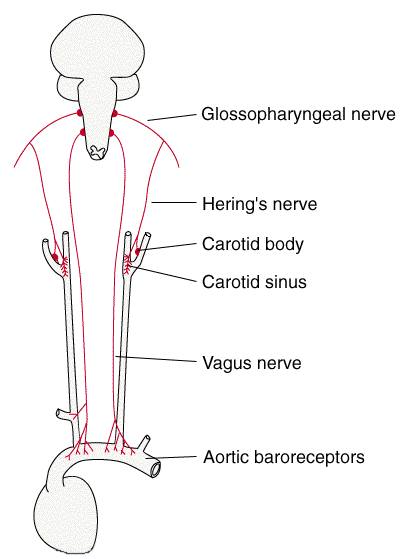
Baroreceptors are sensors found in the major arteries of the body, including the carotoid arteries and the aorta. When the arterial pressure is increased, the sensors are stretched, signals are transmitted into the central nervous system. Feedback signals are sent back to reduce arterial pressure downward toward the normal level. This is a process of negative feedback. This nervous control of the arterial pressure is by far the most rapid of all our mechanisms for pressure control.

A schematic is useful in understanding baroreceptors in arterial pressure control.

This diagram above shows that impulses are transmitted from each carotid sinus through the very small Hering's nerve to the medulla. Impulses from the arch of the of the aorta are transmitted through the vagus nerves to the medulla. Hering's nerve is especially important in physiologic experiments because baroreceptor impulses can be recorded from it with ease.
The diagram below shows the effect of different arterial pressures on the rate of impulse tramission in a Hering nerve. Note that the baroreceptors are not stimulated at all by pressures between 0 and 60 mm. Hg, but above 60 mm. Hg they respond progressively more rapidly and reach a maximum at about 180 mm. Hg.
It especially important that the increase in number of impulses for each unit change in arterial pressure , expressed as (delta)I/(delta)P in the figure, is greatest at a pressure level near the normal mean arterial pressure. This means that the baroreceptors respond most markedly to changes in arterial pressure, even slight change in pressure causes strong sympathetic reflexes to readjust the arterial pressure back to normal.

The next graph illustrates a typical reflex change in arterial pressure caused by clamping the common carotids. This procedure reduces the carotid sinus pressure; as a result, the baroreceptors become inactive and lose their inhibitory effect on the vasomotor center. The vasomotorcenter then becomes much more active than usual, causing the arterial pressure to rise and to remain elevated as long as the carotids are clamped. Removal of the clamps allows the pressure to fall immediately to slightly below normal as a momentary overcompensation and then to return to normal in another minute or so.
